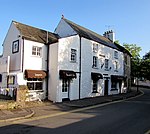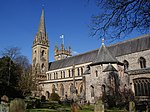St Padarn's Institute

St Padarn's Institute came into being in 2016. Until then the site belonged to St Michael's College, an Anglican theological college in Llandaff, Wales. St Michael's college was founded in Aberdare in 1892, and was situated in Llandaff from 1907 until 2016. Among its many alumni was the poet R. S. Thomas. The original building on the site was a house constructed for himself by John Prichard. After his death, that building was incorporated into the newly-founded St Michael's College, which was built mainly to the designs of F. R. Kempson between 1905-1907. In the late 1950s, a chapel was built by George Pace. The college had significant financial problems in the early 21st century and was eventually closed. The site was purchased by the Church in Wales in 2016 to be used as a residential training college for its full time ministers.
Excerpt from the Wikipedia article St Padarn's Institute (License: CC BY-SA 3.0, Authors, Images).St Padarn's Institute
Cardiff Road, Cardiff Llandaff
Geographical coordinates (GPS) Address Website Nearby Places Show on map
Geographical coordinates (GPS)
| Latitude | Longitude |
|---|---|
| N 51.493 ° | E -3.2187 ° |
Address
Saint Michael's College
Cardiff Road 54
CF5 2YJ Cardiff, Llandaff
Wales, United Kingdom
Open on Google Maps











